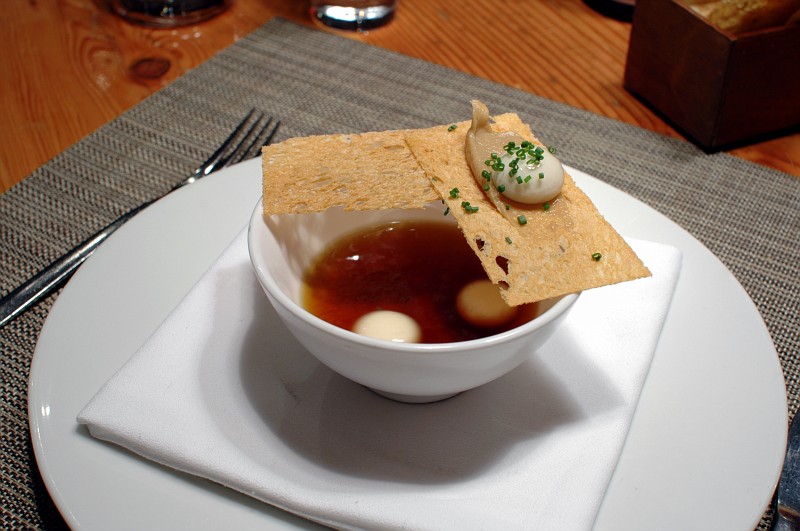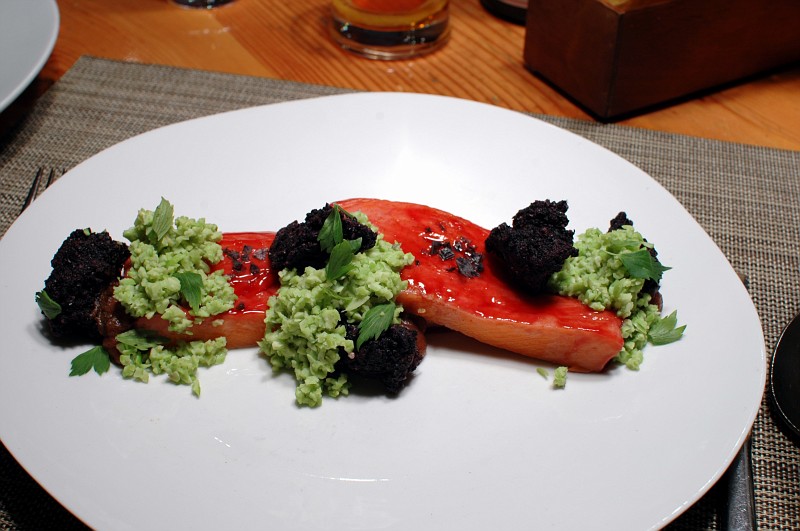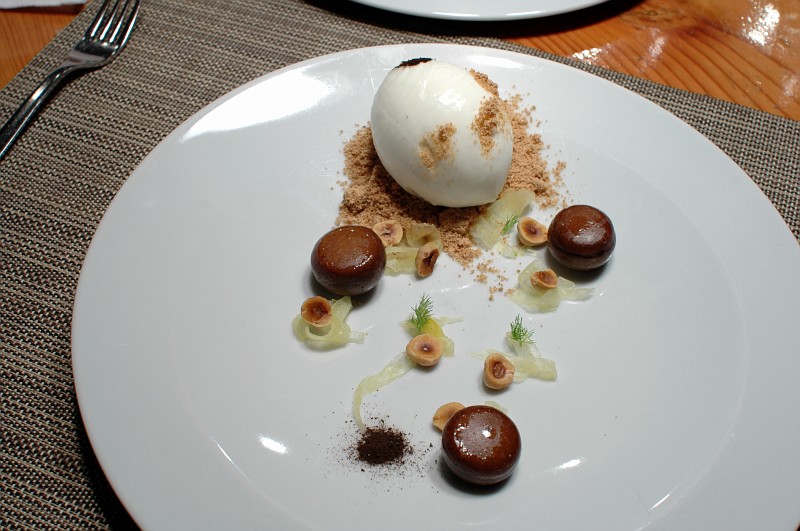wd~50 reconsidered with "Brenda"
by Jason Spiro
As soon as I entered wd~50, I looked back to the open kitchen and to the passe. No Chef expediting. Where's Chef, I ask? He's on his honeymoon. Where? In Hawaii. Congratulations, Chef. So we were to be in Kevin Heston's capable hands that night; no problem, it wasn't the first time.
After a few minutes, we were seated, and sat down with great expectations. I, to be swept away by, and “Brenda,” to be dismissive of, Chef Wylie Dufresne's food. By now the world knows all about Wylie, with his New York Times write up and TV appearances. Some might call him a chemistry kid. Call it molecular gastronomy, call it alternative rock... but don't characterize it at a parodic level. Dufrene is on the forefront of a promising iteration of modern cuisine.
I believe that Wylie is in part questioning the assumptions that underlie what our dining experience consists of, and what constitutes dining out. He and his chefs laboriously experiment with, and reconstitute, a variety of ingredients. The idioms include nouvelle American, tapas, classic French, Asian riffs...but my reference level is not sufficient to comprehend all the flavor combinations. I know, having worked my way through most of the menu, the flavors and textures work for me. He's playful, he obviously has fun, and he knows his stuff.
One can approach a composed plate from different portions, different directions. Again, a chance to scoff at evidence of deconstruction without acknowledging the reconstruction that has taken place. This is something about the entreés that I like quite a bit, but my favorite dishes are the canapés. They can be eaten whole, in one bite, as in an amuse bouche. Since he often provides two to three of these bites, I take the time to unravel the presentation and eat each component individually, savoring first the way the dish stacks up as a whole. Then I take each subsequent bite apart, savoring the cooking techniques, the exactitude of the prep, and the secrets behind the flavor combinations.
On this particular trip, I was not up to my usual vivacious, voracious form and I needed help with the ingredients and preparations. Maybe I just like to see servers spiel food. We had a good one this time, who when asked, recommended the wine we'd decided on among ourselves (the only sure-fire Pinot Noir under $60, an Au Bon Climat 2006).
After we ordered, our amuses arrived in curvy ramekins. Though it was meant to be consumed in one bite, I picked it apart, enjoying the elements of the fish wrapping, the pickled and smoked flavor, and the granola on their own. A strange, subtle, perhaps Korean inflected dish; a sedate and colorless, yet intriguing start.
I ordered the grilled octopus as an appetizer. It arrived as two long tubes of seafood. The first bite was a strong reminder of the taste of octopus, an excellent meat full of flavor. The tiny shreds of lychee shoe leather function both as a deep hued color contrast to the starkness of the octopus tube but also yield pleasure as one tastes both the lychee and Campari in congress. A subsequent bite of the octopus, once plates had been passed, felt less satisfying, as I was left more with the impression of a chewiness and wanting for the sensitivity of a lightly sautéed, simple piece of octopus. Nonetheless, I enjoyed the dish as a whole, as the net result of the creative interplay by young chefs.
It's why I go there. Frankly, I am bored with "good food." Cheek in veal demi, St. Jacques preparations, thyme everywhere, with requisite starch and veg... I am desperate to escape from this mode of fine dining. Granted, Wylie's kitchen doesn't provide the same consistent level of comfort that a traditional Italian or French kitchen might provide--but frankly, I'd rather be left with questions such as, "Why sous vide the fish?" or, "why reconstitute an ingredient that is better fresh?" than wonder why the kitchen couldn't be bothered to put a little white pepper in the mashed potatoes. There are more pressing concerns on the avant-garde of gastronomy. I prefer a series of questions in my head to an ache in my belly; in the case of the former, I want to research and investigate the history of the ingredients Wylie uses, what their typical place is in their own terroirs and season. Thankfully, in the case of the latter, I have never left wd~50 with the slightest hint of indigestion. Presumably this is due to their immaculately clean kitchen and sanitary approaches to food preparation.
I tried the fried quail, which was a meaty piece of the juicy bird, presumably a breast, encased in a little cake of what appeared to be caramelized panko-sized bread crumbs. I believe the final prep took place in a sauté pan, as the cakes left a bit of an oily residue on the plate and in my mouth, slightly overwhelming and mildly unpleasant. However, the counterpoint to this dish, a "banana tartar" was exceptional, dressed in a cream sauce and sprinkled with a slightly tart and spicy herb. How raw banana fits both in the appetizer section, and with a game bird, leaves me puzzled.
Finally the corned duck, that I've had before, which I like very much. I had a realization six weeks ago, before the last time I tried this dish, when I had so tired of bacon wrapped canapés and menu items that I vowed never to have one again: no bacon wrapped shrimp, tenderloin, or scallops. Then I waltz in to wd~50 and order the corned duck. Eaten as a whole it's a very pleasant experience, like eating duck with a bacon texture, with the crunch of a crostini and the freshness of micro greens on top. This time around, I found the horseradish cream (crème fraiche?) to be a little on the sharp side and the bacon to be a bit soft--it hid the secret ingredient from all but the initiated, the amazing tiny slice of garlic sautéed in honey. The salt-yeast paste lightly smeared on the toast was also obscured, but it's an element that reveals itself to either the hearty of palate or those willing to completely unravel the dish and examine it in its component parts. And when all was said and done, on my way home, I realized that I'd eaten a bacon wrapped canapé! Granted, it was wrapped in on itself... but I'd been duped!

French Onion Soup
I insisted on a soup course. I wanted Brenda to try the French onion soup, which I contend is a most cool riff on a classic food item. Frozen cheese is surrounded by a pectin; the cheese maintains its shape in the onion consommé and then explodes on contact with the inside of the mouth. A wafer thin crouton rests on the rim of the miso-style soup cup along with a healthy smear of emulsion of caramelized onion. Another frozen ball of cheese rests on the wafer, meant to be eaten by itself or perhaps dropped into the soup. Either way it completely evokes the taste, if not the texture, of the top layer of bruléed cheese and caramelized onion typically found adhering to the edges of the crock and underneath the cheese brulée. The wafer is a little treasure on display to be eaten, rather than one that one must plunge a spoon into and risk burning one's mouth to taste.
I had the popcorn soup, which was really strange. The creamy broth tasted liked popped corn. "Orville Redenbaccher, I believe," our server informed us when I questioned him about it. A reconstituted shrimp disc rested in the soup, along with a half disc of jicama. Tamarind was present either as a drizzle on the surface of the broth or as a sugary element on top of the jicama. I finished it, playing with the thick popcorn soup on my spoon while we waited for servers to clear our plates on this rather busy night.
On to the main courses. I wanted to order the flatiron steak with coffee gnocchi for the table, as I've enjoyed it so much in the past. But since they ordered the lamb and the pork belly, I felt that so much meat would be overkill. So I ordered the ocean trout.

Ocean Trout
This, I was informed, was cooked sous vide. I have to wonder what was in the bag as it slow poached--how did they achieve the vivid red? Perhaps the low temperature maintains the look, even feel, of the raw fish without the risk, bacterially speaking, of eating raw. The root beer-date, black soybeans, lovage, and forbidden rice all provided interesting counterpoints to the main dish, spread symmetrically along the fish's length. Interesting, though it isn't really a fair or a truly descriptive word. While the fish had a tenderness and flavor that satisfied me on its own, I felt that pairing it with each of the components, particularly the tiny lovage leaves, brought the protein into new contexts. The black crunchiness of the soybean clusters reminded me a bit of Eric Ripert's homemade rice crispies, the root beer gave a welcome sweetness to the fishiness, and the green, shredded, forbidden rice was... well, strange and alien, but good.
The pork belly was satisfying as usual--deep flavor, evenly cooked, though perhaps a bit on the dry or chewy side. But what can one expect, it's stomach muscle, no? I just recall it being a little springier on the palate last time. The caper emulsion satisfied me with its tang, not so much bringing to mind the pickling process that most capers must undergo, and along with the exceptional marinated "ancho" pineapple provided a harmonious whole. Of course pineapple and pork work together. That's what's so exciting about these dishes--I have first, second and third impressions on the palate while I eat, but also I can ruminate on the "why" of the component pairings until potential answers come to mind. In instances such as this, Wylie, his chefs, and Dewey remind me of good vintners or viticulturists, who can fine tune a short run wine vintage and elevate the craft of production to artistic dimensions.
Finally, the lamb loin. A dish to play it safe with. When my companion questioned why she couldn't have her lamb rare, as she always has it, the server warned that the "fat cap" on the lamb made a medium rare preparation more appropriate. We insisted on rare and it arrived without the fat cap. I must admit that the flavor and the components of this dish were most successful from a traditionalist's standpoint. Lovely, firm potato noodles rested in a consomme. A pretzel consomme. What? Yes, a clear broth that tasted of pretzel. What can I say, it worked. Along with mustard crumbs, a series of chunks and cubes that looked like dried Dijon mustard cake (though milder than Dijon), and steamed mustard greens, the dish sang with a simplicity and tenderness that would put a couple of Zagat-friendly Upper East Italian joints I've visited in the past several months to shame.
I stop myself, though, leaving the last piece of lamb for someone else, and plunge back into the difficult ocean trout. Why sous vide fish? What are these strange elements surrounding it? Do I eat them together? I like these questions, I like the confusion, I like the intellectual and emotional search I must make in order to arrive at conclusions. While the crispy soybean cake lacked a little subtlety, I was not turned off. Dufresne makes me wonder what he grew up eating. In turn, I think back to what comforts me and what I expect out of food. Being part of this stage set, being given this experience, is to me a form of success on a level beyond the pursuits of most restaurants thirsting for two NY Times stars. The sense of play, the refusal to remain completely beholden to the past and to old modes of presentation, the desire to redefine what constitutes "au point" or the perfect preparation for an ingredient--it's what keeps me coming back. These are thoughtful men and women. Perhaps, like me, they're tired of traditional dining out. This is not to say that their home cooking is quite different from what they make in the restaurant (or, perhaps, their family meal, which I've heard is "the best in New York City"). I'd imagine that wd~50's chefs enjoy the same home cooked meals we all do. Nonetheless, they raise the bar, they stock the bar differently, just as Vongerichten did before them, once upon a time.
Enough pontification, on to dessert. First we were given a "pre-dessert," a lovely item from the tasting menu described in print as "yogurt, saffron, raisin." Another riff on yogurt and granola, I think, as little specks of oat dotted the dish. Raisin was presented as a puree underneath the dish, a light, mildly sweet, almost airy, dark liquid, and also as currants. The whole raisins were very strong, probably marinated in the saffron.
 Warm gianduja, ice milk, hazelnut, fennel
Warm gianduja, ice milk, hazelnut, fennel The coconut ice cream, the wonderful, if a bit sickly sweet, cherry chocolate morsels, the startling combination of warm gianduja "tartlet" with ice milk, the strange comfort of a brown butter base for a sweet dish... Our three desserts had consistent elements--a kind of advanced ice cream making, shocking ices with savory, smoky garnishes that made for a very satisfying sweet ending to the meal. And two petit fours, a nice faux-marshmallow that I'd had before and a wild chocolate menthol ice cream in a toasted short cake. A riff on tempura ice cream that I can really get behind; the cold of the ice, the pleasure of chocolate cake, and a secondary taste of menthol. The lingering aftertaste, an intermingling of all the flavors, was a testament to the success of this tiny cake.
A four course dinner for three with two coffees and a $58 bottle of wine was $327. Despite my unrealized desire to please my dining companion with this new cuisine, and the slow pace of a very busy Monday night, in hindsight, this was an exciting meal.
You can read more of Jason Spiro's food blogging at http://www.myspace.com/jasonspiro/